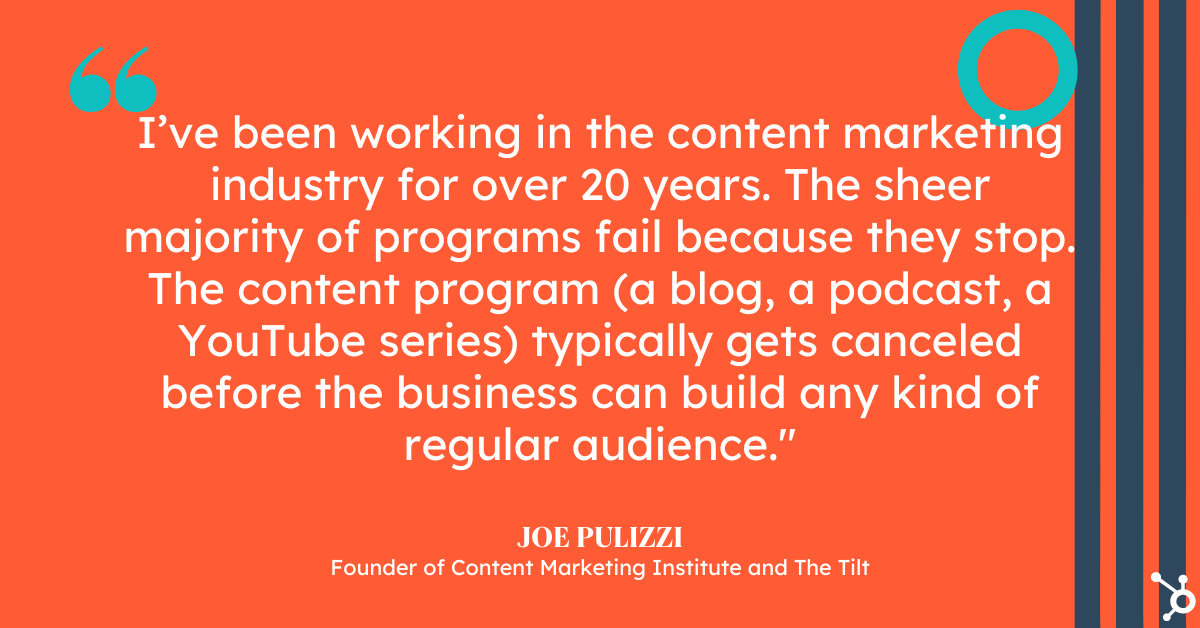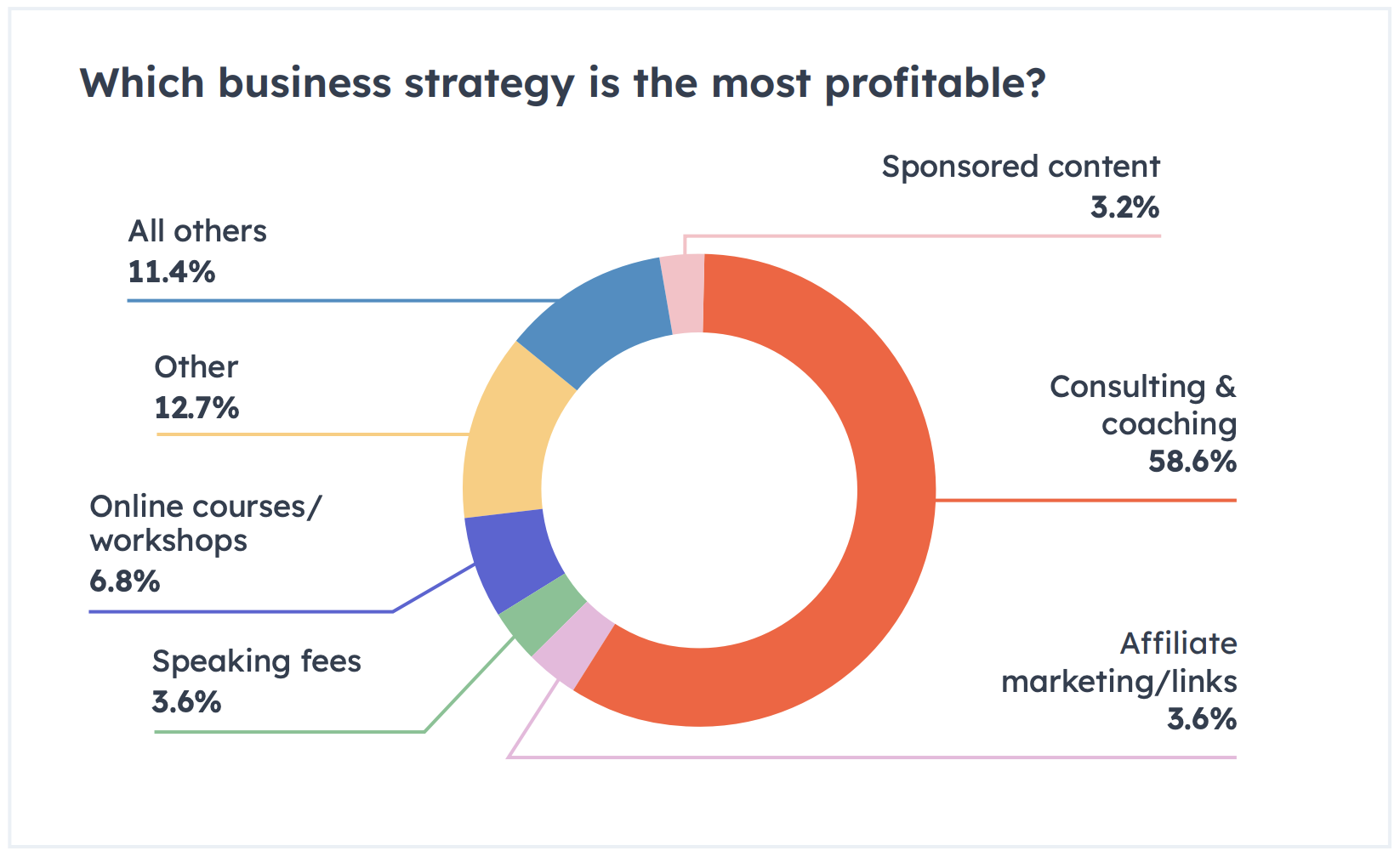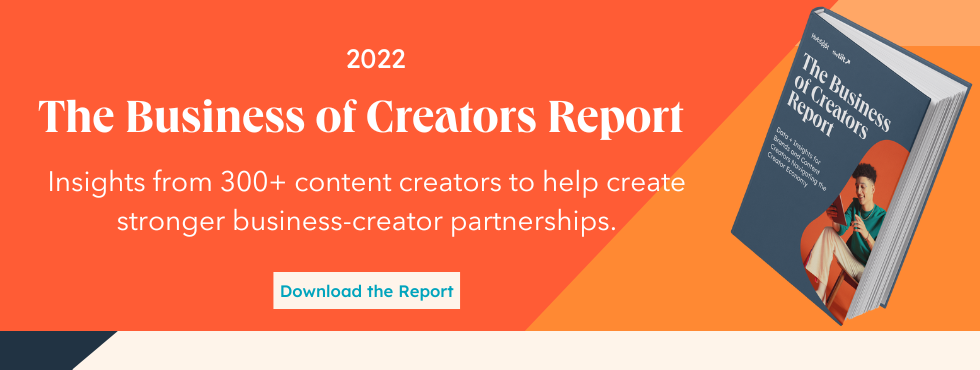Over the last 18 months, the creator economy has been all the rage — and it's proven to be incredibly lucrative. In fact, as of 2022, the creator economy's market size is estimated at $104.2 billion.
The creator economy is made up of bloggers, podcasters, YouTubers, newsletter writers, TikTok and Instagram influencers, and others who are trying to build real businesses by creating and distributing valuable and entertaining content.
Think of these content creators as little media companies.
Many of these content creators work with bigger brands rather than sell their own products or services. If you're a marketer whose interested in working with content creators to expand your audience reach, keep reading — we'll dive into everything you need to know when working with a content creator, backed by data.
(Alternatively, you can also take a look at the complete Business of Creators report we at the Tilt created in partnership with HubSpot by downloading it here.)
To start, let's explore what we know about content creators.
The Creator Economy: A Content Creator's Interests, Challenges, Revenue Streams, & More [New Data]
Who are content creators?
Although many like to focus on the “content creation” part, content creators are individuals who are also entrepreneurs and business owners. I like to refer to them as content entrepreneurs who:
- Deliver consistent information to a group of people with plans to build a loyal audience and then monetize that audience over time.
- Create content to build a long-term, successful business (not as a hobby).
- Begin primarily on one channel (e.g. as a podcaster, a blogger, a YouTuber) and then diversify into many channels.
- Generate revenue from their audience in multiple ways, including sponsorship, subscription, courses, speaking, consulting, and even products and services.
Take Jimmy Donaldson, aka MrBeast. Jimmy started creating YouTube videos about 10 years ago. After years of testing and trials, Jimmy found a regular schedule of videos after three years and began to build a following.
By 2016, he had 30,000 subscribers. The next year he hit one million subs.
Today, he makes more than 54 million dollars a year, launching products such as MrBeast Burger and a thriving snacks business called Feastables.
Although MrBeast may be an outlier, the model is simple: Build an audience on one platform, create a strong differentiation area, and consistently publish over time. Once an audience is built, then the creator monetizes the platform with diverse revenue streams. It’s the combination of being a content creator and an entrepreneur that makes the model work.
Whether that platform is a podcast, a blog, a book, an Instagram series, or a YouTube show (like MrBeast), the model works the same. It happened at Morning Brew. It happened for the Hustle. It’s happening everywhere all over the world.
Why the Creator Economy is Booming
Today, anyone with just a smartphone can become a content creator. There are no barriers to entry in becoming a content entrepreneur.
But that doesn’t mean it’s easy. On average, it takes a full-time content creator 17 months just to break even. Just think if Jimmy Donaldson quit after two years and a handful of YouTube videos?
The creator must deliver consistently over a long period of time just to start to build an audience that can be monetized.
Why do content creators choose this kind of business?
Although some of these businesses look like side hustles, about 40% of content creators have built financially sustainable businesses (i.e. they are supporting themselves or others). Of the content creators we surveyed, the average individual has been creating and monetizing their content for at least three years.
These entrepreneurs want to make money — but it’s more than that. 80% of content creators do it because they enjoy it. Although it's challenging, it’s a fun business … one that can be done at almost any location on the planet with minimal expenses.
In actuality, content creators may be some of the most satisfied with their chosen profession out of anyone. A full 96% of creators say they do not regret their decision to become creators.
Of all the reasons to become content creators, one in three do it because they can be their own boss. The next three highest reasons include:
- the enjoyment of the work
- the ability to pursue a passion
- flexible work hours

What are the key challenges for content creators?
The key challenges are two-fold. First, the creator must find what we call a content tilt. The content tilt is an area of differentiation where the content creator can actually break through all the informational clutter and gain attention.
Simply put, is the content different enough and targeting a niche enough audience where the possibility exists to be an expert?
Ann Reardon, known as the baking queen of Sydney, Australia, started a video blog in 2011 where she discussed step-by-step food recipes. Food is one of the most competitive content areas. How does someone break through with minimal resources?
Ann decided to do something different to stand out. Every week she created videos on “impossible dessert creations”. At that time, no one was doing that, and she quickly gained a following.
Today, she is a successful content entrepreneur with five million YouTube subscribers and a best-selling book.
The second challenge is consistency. I’ve been working in the content marketing industry for over 20 years. The sheer majority of programs fail because they stop. The content program (a blog, a podcast, a YouTube series) typically gets canceled before the business can build any kind of regular audience.

We launched Content Marketing Institute in 2007. It took 22 months of regular blog posting to get to 10,000 email subscribers. We delivered consistently, five days per week, and built a loyal and trusting audience. In 2011 we hit a million dollars in revenue. By 2015 we were a $10 million dollar company.
To be successful, content creators can’t stop. If you stop, even for a day, you give your audience an opportunity to look elsewhere for their information. Sadly, you might never get that audience back.
How do content creators make money?
Almost 60% of content creators have a coaching or consulting practice. For this category of content, consulting is “low-hanging fruit” revenue.
But it doesn’t stop there. Content creators seek to diversify revenue streams as quickly as possible, adding revenue lines such as:
- Affiliate revenue
- Online courses and memberships
- Speaking fees
- Sponsored content
- Advertising and sponsorships on their emails and podcasts

According to our report, nearly seven out of 10 content creators are not satisfied with their revenue streams. So, even though the creator economy industry is growing, most creators have a long way to go.
How much time do they spend actually creating content?
For a content entrepreneur to be successful, they can’t focus on creating content all the time. content creators spend about 45% of their time creating their content, and then about 20% promoting and distributing their content.
The other 35% of the time they are working on the business, including marketing and sales, operations, and administration. As a content creator becomes more experienced, they begin to spend less time creating content and more time monetizing their content.

How do content creators initially fund their businesses?
As we discussed, it usually takes about a year and half or more just to break even.
Content creators need to support themselves and their families over that time, or treat the business as a “side hustle” until the business becomes profitable.
Funding generally comes from a variety of sources, including personal savings, credit cards, loans from family members and (per the term “side hustle”) income from another job.
Now that we've covered what we know about content creators, let's discuss why you should care.
Why Marketers Should Care About Content Creators
As a marketing professional in a small-to-medium-sized business, you wear many hats. You probably create vast amounts of content yourself. The problem is, you can’t focus on only doing that. That’s where it becomes valuable to work with a content creator in your industry.
These creators have engaged, loyal followings, so working with a content creator enables you to reach new audiences quickly. And the good news is that the majority of content creators are extremely open to working with brands, helping you reach your audience through their channels in exchange for money or other benefits.
These partnerships could look as basic as you sponsoring their email or podcast — or as complex as a joint research project or ebook.
How Marketers Can Start Working with Content Creators
First off, you'll want to develop a list of creators that reach your target audience. Do some qualitative research with your audience to find out what they are reading, listening to, or watching. Additionally, you might leverage tools that can help you identify content creators in your niche, such as podcast directories for podcasts.
Next, I'd advise you to start with a list of five to ten creators. Consider all the different platforms, including Instagram, TikTok, newsletters, books, and even a streaming service like Twitch.
Once you have the list, make sure those creators align with your company mission and brand values. This is critically important. Just look at Adidas and their relationship with Kanye West. This was a billion dollar partnership and the program worked spectacularly, but Adidas was affected by everything that Kanye said or did outside their program. Basically, when you partner with a creator, you get the entire package, good or bad. So vet your list to only the creators that make sense.
Once that is complete, test out a partnership with one or two. It makes sense to start simply by sponsoring a creator project or running an advertisement in one of their offerings. How did it go? What were the results? Is it really the correct audience for what you are trying to do?
A few years back, we were interested in partnering with a creator on an event. Before we did that, we attended multiple events run by this creator. We even sponsored one. When the results came back positive, we decided to create a formal partnership.
Once you’ve identified, vetted, and tested a program with the creator, you'll want to develop a partnership agreement. Here's a good example of one.
Generally, a partnership agreement includes the expectations of both parties, the timeline, the budget, promotional efforts, approvals and permissions, and any legal documents necessary. Best advice? Plan for the effort NOT to work. Make sure you put an easy out (for both sides) into the agreement if things go south. If it works, fantastic, but best to plan for the worst.
Consider Acquiring the Creator's Business
The good news is that this method can be used for an extra opportunity: Acquiring the creator’s business.
Let’s face it, creating compelling content and building a loyal audience is extremely difficult. Hopefully, if you’ve done your homework, you’ve identified a number of creators who have already done the heavy lifting. So if your partnership and test projects have passed with flying colors, you may be interested in the next step.
According to The Tilt, 20% of creators are actively looking to sell their content business. In many cases, they’ve done the hard work and want to be compensated a bit more. If you have a budget set aside for something like this, it could be a match made in heaven.
While at Content Marketing Institute, we needed a west-coast technology event and an awards program. Instead of investing six figures and waiting two-to-three years for us to organically grow these, we went out and purchased both.
If this is in your wheelhouse, use the same process as above to vet your creators. At the same time, meet with whoever owns the M&A budget in your organization and talk through the opportunities.
Although these types of deals are becoming more ordinary, this is still a new muscle for most organizations. Simply put, marketers think organic growth instead of acquisition growth. Although this is changing, the process is still new to most.
Start Engaging with Creators
If you are new to the creator economy, working with content creators will take some time. There is some added pressure because most organizations today realize the opportunities and are committing resources to this area.
That said, at minimum, start engaging with the creators in your industry. Listen to their podcasts. Read their newsletters. Watch their YouTube channels. That may be enough for now. The opportunities will come.
![Why the Creator Economy is a Huge Opportunity for Marketers, According to Joe Pulizzi [+ New Data]](https://localseoresources.com/wp-content/uploads/https://no-cache.hubspot.com/cta/default/53/5478fa12-4cc3-4140-ba96-bc103eeb873e.png)
![Download Now: 150+ Content Creation Templates [Free Kit]](https://localseoresources.com/wp-content/uploads/2022/11/5478fa12-4cc3-4140-ba96-bc103eeb873e.png)


Recent Comments